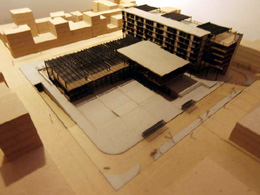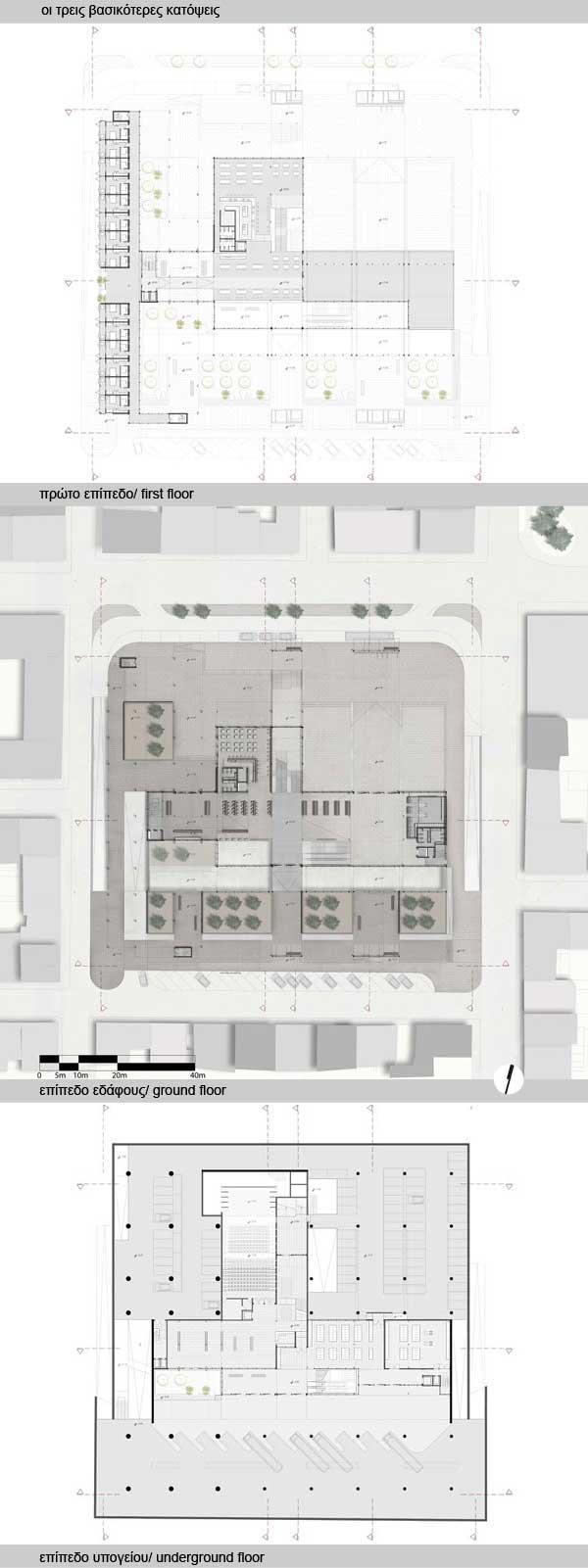STUDENTS PROJECTS
PROJECTS2012

02 April, 2013
In.Bu.S, Intercity Bus Station in Chania, Crete
Towards a structure that allows the bus in the centre of the city and towards a combination of uses that makes the characterisation "non-place" no longer valid for the spaces of transit.
Students: Bregiannis Kyriakos, Gorantonaki Tzeny
Supervisors: Oungrinis Kostis, Tsakalakis Dimitris
Technical University of Crete, Department of Architecture
Presentation date: 17 September 2012
The existing bus station is located near the 1866 Square which is one of the three main squares in the city of Chania. Along with the Old Market Square and Square of Law Court, they delineate the centre of the city. The premises around the square are mostly used for trading and touristic purposes, while very few of them are used for housing, which is mostly dominant in the southwest of the area.
Chania holds great significance for the inhabitants of the whole county of Chania. It is indicative the fact that students from various villages and cities all around the county come here for school even though there are other schools nearby. The city is also a popular destination for holidays, which almost doubles her population during the summer. This is ascribed not only to the incoming tourists, but also to the local people who come for work. Thus, the intercity bus is one of the most important mean of transport throughout the year and especially during the summer.
The location of the station enhances its importance for the everyday life. The station is right next to the centre of the city, which makes the bus more popular and, at the same time, makes the city easy and relatively inexpensive to access.

Nevertheless and despite the central location of the station, its design does not meet the needs for its function and it does not enhance or promote in any way the character of the city. As the image shows, the space is almost empty, a void in the city. The indoor space for passengers' services is very small and confined, while the outdoor space is mostly dedicated to bus parking. In that way, both passengers and workers, such as the bus drivers are unhappy; the first because they do not have space for waiting and the second because the design of the space makes difficult the whole circulation of the busses (departure, arrival, loading). To this also contributes the oneway direction system, which has as a result that the busses depart from a low traffic but very small road while they arrive from a big but high traffic road.
What's more, the space is isolated from the 1866 Square, and therefore the city as well. The space is enclosed by a fence for security purposes, leaving space only for "doors" in order to let people in and out of the station, which creates problems in wayfinding and orientation, as well as their safety; people and busses use the same space. To make matters worse, the corners of the whole area are occupied by high rise buildings, namely hotels, on the northeast side and smaller buildings, namely houses, on the southwest side, which makes the station completely unrecognisable and therefore hard to find.
As a consequence, our design had to address those problems providing the city with a proper public infrastructure. It is based on two basic choices; first, the demolition of the physical boundaries between the city and the station, that is the fence and the buildings, and second, departures and arrivals, as well as parking and maintenance of the bus go underground and are distributed in two levels. This allows the creation of open outdoor spaces, one main and two secondary, which not only signify the entrances of the station but also enhance the meaning of the station as public infrastructure connecting it with the city life.

The role of these small squares goes even further. They are anticipated to function as space of movement for lots of people, who, in turn, will function as a kind of spectacle, like an open-air theatre, for the people in the station, who will probably be waiting for the bus to leave. Watching other people in public is one of the most favourite activities, thus creating a pleasant stay and most importantly, a pleasant wait inside and outside the station.
Furthermore, the station is designed to cover various and diverse needs for three main categories of its users, the inhabitant, the tourist and the passenger. Each one of them moves in very different ways in space, thus bringing them together creates a hospitable environment. For example, one who is in a hurry is next to the one who is wandering around gazing at the surroundings, without the one disturbing the movement of the other.



Bringing them together also covers different scenarios of use. For example, this can address the needs for a theatrical play in theatre of the station, which will be the first as big in Chania or, in combination with the hotel and the restaurant, the space can even host a conference. In this way, the In.Bu.S. cannot only solve its economical resources but also provide the city with a multifaceted space.





Related articles:
- Urban reconstruction using the train ( 11 March, 2011 )
- Central bus station in the area of Eleonas - Botanikos ( 26 April, 2011 )
- Metro station “KERAMIKOS” ( 29 June, 2012 )
- Gullesfjord Weight Control Station ( 23 October, 2012 )
- Suburban Railway Station. Urban regeneration in Rouf, Athens, Greece ( 21 January, 2013 )
- Interventions on the urban railway stations of the network Patras - Rio ( 13 February, 2013 )
- Railway Station Complex in St. Denis district in Patras, Greece ( 11 April, 2013 )
- Souda Port Passenger Station, Souda Bay,Chania,Crete ( 10 June, 2013 )
- Railscapes: Tracing routes of rail history ( 17 March, 2014 )










